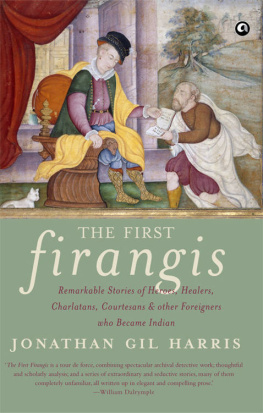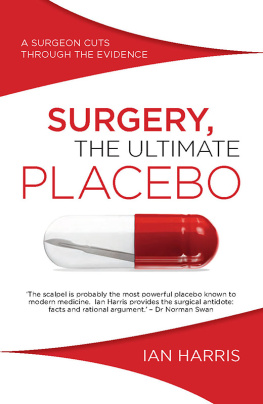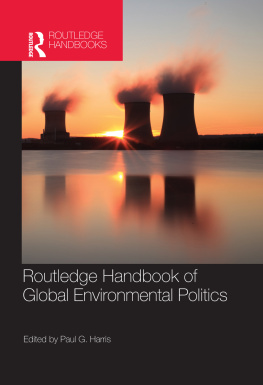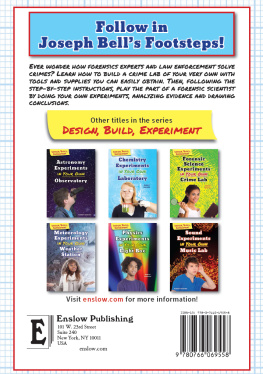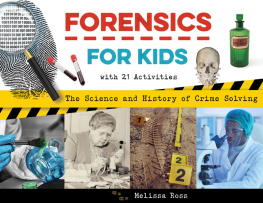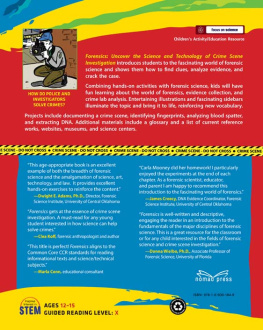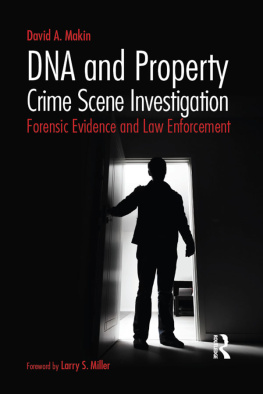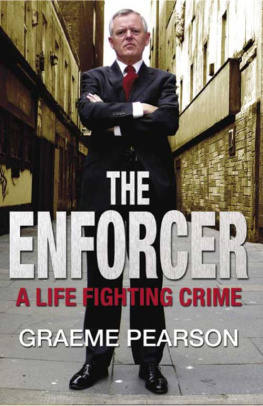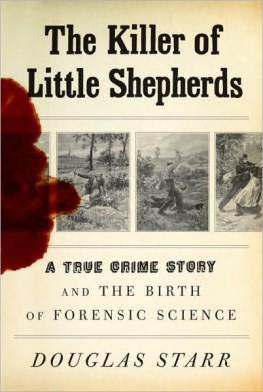Harris - Crime fighting: the impact of science and technology
Here you can read online Harris - Crime fighting: the impact of science and technology full text of the book (entire story) in english for free. Download pdf and epub, get meaning, cover and reviews about this ebook. City: London;Mankato;Minn, year: 2012, publisher: Britannica Digital Learning;Arcturus Pub., Encyclopedia Britannica, genre: Politics. Description of the work, (preface) as well as reviews are available. Best literature library LitArk.com created for fans of good reading and offers a wide selection of genres:
Romance novel
Science fiction
Adventure
Detective
Science
History
Home and family
Prose
Art
Politics
Computer
Non-fiction
Religion
Business
Children
Humor
Choose a favorite category and find really read worthwhile books. Enjoy immersion in the world of imagination, feel the emotions of the characters or learn something new for yourself, make an fascinating discovery.

Crime fighting: the impact of science and technology: summary, description and annotation
We offer to read an annotation, description, summary or preface (depends on what the author of the book "Crime fighting: the impact of science and technology" wrote himself). If you haven't found the necessary information about the book — write in the comments, we will try to find it.
Crime Fighting examines advancements in forensic science and crime fighting.
Harris: author's other books
Who wrote Crime fighting: the impact of science and technology? Find out the surname, the name of the author of the book and a list of all author's works by series.
Crime fighting: the impact of science and technology — read online for free the complete book (whole text) full work
Below is the text of the book, divided by pages. System saving the place of the last page read, allows you to conveniently read the book "Crime fighting: the impact of science and technology" online for free, without having to search again every time where you left off. Put a bookmark, and you can go to the page where you finished reading at any time.
Font size:
Interval:
Bookmark:

E-book published in 2012 by Encyclopdia Britannica, Inc., in association with Arcturus Publishing Limited, 26/27 Bickels Yard, 151-153 Bermondsey Street, London SE1 3HA. Britannica, Encyclopdia Britannica, and the Thistle logo are registered trademarks of Encyclopdia Britannica, Inc.
Please visit our web site at: www.garethstevens.com.
For a free color catalog describing Gareth Stevens Publishings list of high-quality books, call 1-800-542-2595 (USA) or 1-800-387-3178 (Canada). Gareth Stevens Publishings fax: 1-877-545-2596
Library of Congress Cataloging-in-Publication Data
Harris, Nathaniel, 1937
Crime fighting : the impact of science and technology / by Nathaniel Harris.
p. cm. (Pros and cons)
Includes bibliographical references and index.
ISBN: 978-1-61535-609-6 (e-book)
1. Criminal investigationJuvenile literature. I. Title.
HV8073.8.H37 2010
363.25dc22
2009012433
This North American edition published in 2010 by Gareth Stevens Publishing under license from Arcturus Publishing Limited.
Gareth Stevens Publishing
A Weekly Reader Company
1 Readers Digest Road
Pleasantville, NY 10570-7000 USA
Copyright 2009 Arcturus Publishing Limited
Produced by Arcturus Publishing Limited
26/27 Bickels Yard
151-153 Bermondsey Street
London SE1 3HA
Gareth Stevens Executive Managing Editor: Lisa M. Herrington
Gareth Stevens Editors: Jayne Keedle, Joann Jovinelly
Gareth Stevens Senior Designer: Keith Plechaty
Series Concept: Alex Woolf
Editor and Picture Researcher: Nicola Barber
Cover Design: Phipps Design
Consultant: Miles Hudson
Picture Credits: Corbis: 8 (Brooks Kraft), 11 (Bettmann), 12 (Digital Art), 13 (Jerry McCrea/The Star Ledger), 16 (Andy Rain/epa), 19 (Alessia Pierdomenico/Reuters), 30 (Yahya Arhab/epa), 32 (Narendra Shrestha/epa), 46 (Gideon Mendel), 48 (Jerome Sessini); Rex Features: 52 (Giles Moberly/PYMCA); Science Photo Library: Cover (Pasieka), 5 (Philippe Psaila), 22 (George Steinmetz), 29 (Photo Researchers), 35 (Michael Donne, University of Manchester), 36 (Mauro Fermariello), 39 (Michel Viard, Peter Arnold, Inc.), 43 (Dr. Jurgen Scriba), 44 (Tek Image), 50 (Ted Kinsman), 55 (Andrew Brookes, National Physical Laboratory), 59 (Charles D. Winters); Shutterstock: 7 (Dusan Po), 15 (Mikael Damkier), 21 (Pres Panayotov), 25 (Gary Blakeley), 26 (Gary Yim), 41 (Benjaminet), 57 (Yuyangc).
Cover: A computer-generated image of a glowing handprint shows its individual details. Just as fingerprints are unique to each person, palm prints can also be used to link possible suspects to crime scenes.
Every attempt has been made to clear copyright. Should there be any inadvertent omission, please apply to the copyright holder for rectification.
All rights reserved.
1 2 3 4 5 6 7 8 9 15 14 13 12 11 10 09
CHAPTER 1
Science and Crime
CHAPTER 2
The Computer Age
CHAPTER 3
Watching and Listening
CHAPTER 4
Global Threats
CHAPTER 5
Questions of Identity
CHAPTER 6
In the Line of Duty
CHAPTER 7
The Future of Crime Fighting
Science and Crime
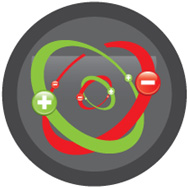
On August 4, 1892, 32-year-old Lizzie Borden found her father and stepmother dead in the family home at Fall River, Massachusetts. An apparently frenzied attacker had smashed their heads with repeated ax blows. The Bordens family had been unhappy, and much of the evidence pointed to Lizzie as the murderer. She was put on trial, but the jury was not quite convinced of her guilt and found her innocent.
The Borden case became one of the United States most famous unsolved murders. Today, scientific investigators would almost certainly find the conclusive evidence needed to prove or disprove Lizzies guilt. That might, for example, take the form of microscopic spots of blood, or near-invisible fibers that could be shown to have come from an intruders clothing if there was an intruder.
Science-based techniques and tools have since transformed the process of criminal investigation. Scientific techniques have not, however, replaced traditional police work, which remains vital. Police officers question witnesses and suspects, take statements, conduct door-to-door investigations, and appeal to the public for information. Police detectives examine what the evidence means, search for motives, and follow leads until they identify and arrest the suspected criminals.
Blood Will Tell
Violent crimes generally leave behind a trail of blood. Crime investigators can learn much from the shapes of blood drops, splashes, and stains. They are often able to reconstruct what happened at the crime scene, including the victims movements after being struck, or the direction from which he or she was wounded. Every human being has blood that belongs to one of four types. That fact can help prove a persons guilt or innocence. If your blood belongs to a different blood type from that of a wanted criminal, you cannot be that person.

At a crime scene, investigators collect evidence, which is bagged and labeled. The investigators wear protective clean suits that protect them from harmful substances and ensure they do not contaminate the scene or its evidence.
Until the 1950s, detectives took the leading role in investigating crime scenes. The crime scene is the place where a crime has been committed, or any place where useful evidence is discovered. The crime scene is closed off and the first people to enter it are experts wearing white clean suits, including gloves, masks, and boots. Those uniforms and gear protect experts from on-site infections. The suits also ensure that nothing from the experts own bodies becomes mixed with evidence. Without such precautions, biological material from an investigator might contaminate the crime scene, or taint useful evidence from it. Contaminated evidence may be rejected in court. Expert photographers record every aspect of the crime scene before investigators may touch anything. Investigators then search for evidence, placing samples of anything movable, such as hair strands or cloth fibers, into bags that are carefully sealed and labeled.
If there is a body at the crime scene, a pathologist, or medical examiner, will examine it before it is removed. A pathologist is an expert in identifying cause of death. He or she detects and analyzes diseases and wounds. Later, he or she will perform a post-mortem examination, or autopsy. That is a surgical examination of a dead body to determine how and when the person died, the nature of his or her injuries, and what kind of weapon wounded him or her. Sometimes the pathologist can determine specific details, such as the likely height and build of the attacker.
Back in the laboratory, experts use a variety of scientific resources to extract information from evidence found at the scene. Specialists test samples of blood, hair, and body fluids. Those may prove decisive in identifying who was present at the time. Minute fibers, soil quality, seeds, or even pollen grains may also offer important clues. All substances from the crime scene are analyzed and identified.
Next pageFont size:
Interval:
Bookmark:
Similar books «Crime fighting: the impact of science and technology»
Look at similar books to Crime fighting: the impact of science and technology. We have selected literature similar in name and meaning in the hope of providing readers with more options to find new, interesting, not yet read works.
Discussion, reviews of the book Crime fighting: the impact of science and technology and just readers' own opinions. Leave your comments, write what you think about the work, its meaning or the main characters. Specify what exactly you liked and what you didn't like, and why you think so.


